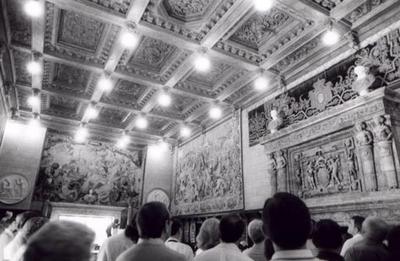
William M. Dowd photo
SAN SIMEON, CA --When media mogul William Randolph Hearst decided to create his own art-filled paradise on a mountaintop north of San Francisco, he selected a spot called San Simeon.
He preferred to call it La Cuesta Encantada -- the Enchanted Hill.
The fabulous Hearst Castle complex houses what was the largest one-person-owned art collection in the 20th Century. Hearst had individual pieces of art, tapestry collections, statuary -- even entire buildings -- he purchased on his many world travels crated and shipped back to the United States. So extensive was the collection, some treasures have never been unpacked, and remain warehoused off-site.
In addition, he had many species of plants and animals brought in to populate the mountaintop lair as well as on the land encompassed by the vast Hearst Ranch down at sea level on the surrounding flatlands.
Excavation on the project began in 1922, and in 1927 Hearst moved into the partially-completed complex -- the period in which he reigned as a Hollywood mogul and entertained the likes of Charlie Chaplin, Douglas Fairbanks, Mary Pickford and his own mistress, actress Marian Davies. Work continued off and on through 1947.
On the main grounds is a series of "cottages" that actually are lavish guest houses, all of which at one time played host to the Hollywood elite for elaborate picnics, tennis tournaments, musical entertainments and private film screenings. The edifice and the lifestyle were the basis for actor/director Orson Welles' controversial and classic film "Citizen Kane" in which a fictitious character named Charles Foster Kane functioned as a thinly-veiled version of Welles' uncomplimentary view of Hearst.
The State of California now owns the complex, donated to it by The Hearst Corp. It is open to the public for guided tours.
One of the most fascinating aspects of seeing the castle and grounds is the realization that it is not just a trove of treasures from many of the world's great civilizations, but each room is in itself a work of art rather than simply a display case for the treasures.
We've all shared our memories of places we've visited, explaining, for example, lovely pieces of artwork we've seen hanging on walls of museums and mansions. At the Hearst Castle, however, the walls themselves are works of art. Some were moved whole from the Doge's Palace in Venice, some from ancient Egyptian excavations. Floors from Moorish castles are the floors of some of the Hearst rooms. Statues and columns lining the mosaic-tiled pools were not made for that purpose; they were repurposed from ancient Roman and Greek ruins.
The Hearst Corp., which still owns the ranch, has plans to create a resort complex there as well as continuing its cattle and agricultural pursuits.
ON THE WEB
• Dowd's Guides